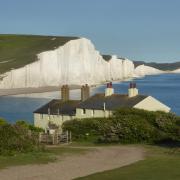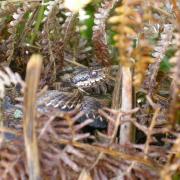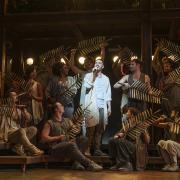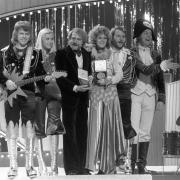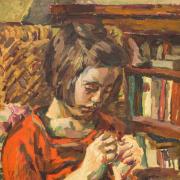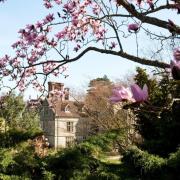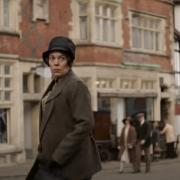Solution for the “Cor Cordium” piece by Tony Ward in the Sussex Life March issue
Who is it? Cor Cordium
A birthright rejected, a driven soul, a final storm.
Childhood days, happy days, fishing, hunting, walks in the moonlight.
Change... too soon from Sussex fields to playing fields
of Eton. The dreamer displaced, friendless, tormented.
Change... onwards and upwards, the well-worn path
to Oxford. Writer, radical, rebel,
polemic in a paper boat, a step too far,
Expelled.
.
A flight, a teenage marriage. Failed.
His wife, his child, abandoned for another.
A flight once more, a continental tour. Cut short.
To Mary a daughter, to Mary a son.
Abroad again, on Lake Geneva’s shores, ghosts, stories,
To Mary... a monster.
.
Travellers. Florence, Pisa, Rome.
And writing. Poems epic, poems lyric,
poems of protest, poems of love,
Elegies and tragedies,
and tragedies their own.
.
Death of a sister, death of a wife,
death of a daughter, death of a son.
“Alas I have nor hope nor health
Nor peace within nor calm around”
.
A reckless journey, the final storm,
Ariel lost beneath the waves.
Ten miles to sea, ten days to shore,
no hands, no face. Known by
the poems in his pocket. Known by
the clothes that he wore.
.
Ariel’s song adorns his grave.
Ashes in Rome, his heart brought home. Reunited,
In Mary’s tomb, “Why not I with thine?”
A tragic life, a tragic death, but sowing seeds.
Writers, reformers, composers, performers -
the harvesters, heirs to his vision,
The Triumph of Life.
Solution – Percy Bysshe Shelley – English Romantic Poet (1792-1822)
Explanation of embedded clues
The poem title, the Latin phrase ‘COR CORDIUM’ (“Heart of Hearts”) appears on Shelley’s gravestone in the Protestant Cemetery in Rome (Campo Cestio). The cemetery is also known as the Acatholic Cemetery, the English Cemetery, or the Cemetery of Poets. His friend John Keats is also buried there. (Keats own epitaph reads ‘Here lies one whose name was writ in water’). The burial of Shelley’s ashes in that ground, with that inscription, is doubly ironic. Firstly, he was a lifelong atheist, and secondly, his actual heart was removed from his funeral pyre and taken back to England (more of that later).
Percy Bysshe Shelley was born on 4 August 1792 in Field Place, in the parish of Warnham, about one mile north-east of the village of Broadbridge Heath on the outskirts of Horsham, West Sussex. Field Place is now a Grade 1 Listed Building, the earliest parts dating back to the 15th Century. Shelley was baptised on 7 September 1792 in Warnham Church and up to the age of 10 enjoyed an idyllic childhood in the local Sussex countryside. The “walks in the moonlight” were to visit his grandfather at Arun House in Horsham. He is said to have sheltered in a Broadbridge Heath barn on at least one occasion. Perhaps he got caught in a storm or the moon didn’t sufficiently light his way? The barn later (1905) became the first clubhouse for Horsham Golf Club’s original 9-hole layout (the club relocated to Mannings Heath in 1914). The opening line of the poem gives a 9-word summary of what was to come, his life and tragic early death.
Percy was the eldest of six children, the heir of Sir Timothy Shelley MP and his landowning wife Elizabeth (Pilford). His grandfather was a Baronet and his uncle was a famous Naval Commander who served under Admiral Nelson during the Battle of Trafalgar. He was born into privilege and prosperity, solid, conservative aristocratic stock, but “A birthright rejected”. He was to shock Regency England with his revolutionary political idealism.
Sent away firstly to school at Syon House Academy in Brentford, Middlesex, he was prepared for his entry to Eton College in 1804. Although academically he succeeded in gaining entrance to University College, Oxford, socially Eton was a disaster. Shelley was a quiet, rather eccentric character, shoelaces undone, a bit of a daydreamer, always with his nose in a book, a bit of a ‘swot’. He already had strong views on respect for the rights of others and would not take part in ‘fagging’. Coupled with his indifference to sport and other youthful activities this set him apart. He was nicknamed ‘Mad Shelley’ and suffered almost daily taunting, ‘Shelley-baiting”, by the other boys. He lashed out, ineffectually, at his tormentors and of course this just made things worse. He made no friends at Eton.
He trod “the well-worn path to Oxford” in 1810. He rarely attended lectures, but read and wrote constantly. In the course of one year he published two Gothic novels and two poetry collections, including works by others as well as his own pieces. University College had a strong Christian tradition and so his next pamphlet, The Necessity of Atheism, led to his expulsion. (Although the 2006 rediscovery of an anti-monarchical and anti-war poem of his, also written in 2011, suggests that there may have been a political as well as theological basis for his expulsion). “Polemic in a paper boat” was in truth a post-expulsion development. Shelley adopted some very odd ways to distribute his flow of political pamphlets, sending them out in paper boats or bottles in waterways or inside hot-air balloons.
Verse two concerns Shelley’s two marriages, in both cases he took up with 16 year-olds. Soon after being sent down from Oxford, at the age of 19, he eloped to Scotland and married Harriet Westbrook, a school friend of his sister. Harriet bore him two children, but the marriage failed. Harriet was not his intellectual equal. Three years after his marriage to Harriet, he became besotted with Mary Godwin. Mary was the highly educated daughter of two intellectual heavyweights. Her father, and Shelley’s mentor at the time, was the like-minded social reformer William Godwin and her mother was the feminist Mary Wollstonecraft. Mary Godwin was someone he could talk to.
The flight this time was to the continent, through France to Switzerland, in the company of Mary’s stepsister, Claire Clairmont. Claire could speak French. Like later young Inter-Railers, after six weeks they had had enough. They had run out of money. They were homesick. Mary was pregnant. Their daughter was born in February 1815, but only lived for a few weeks. Within a few months Mary was pregnant again. This time their son, William, survived through infancy.
“Abroad again”, Mary, Shelley and Claire spent the summer of 1816 at Lake Geneva.
Shelley’s poetry writing had by now received some acclaim. An early influence had been Wordsworth (1770-1850) and he was now to meet with the self-exiled Lord Byron. The two men rented nearby houses on the Lake. One evening, at Byron’s place, he invited his guests to take part in a ‘ghost story contest’.
Mary, then 18 years old, mulled this over for several days before coming up with the idea of a young science student who by means of a very unorthodox experiment creates a living creature from the body parts of the dead, only to be horrified by the monster he had created. Two years later Frankenstein was published. It is not recorded as to whether Mary won the contest!
Early in 1818 the Shelleys took to the road again, this time in Italy, leaving England for good - “Travellers. Florence, Pisa, Rome”. Travelling and writing, meeting fellow poets, Shelley’s output was by now wide-ranging and immense. His best known short poem, a sonnet, ‘Ozymandias of Egypt’, written before their departure, also featured a Traveller – ‘I met a traveller from an antique land ...’. It was however during their own travels that one of Shelley’s best-known longer works was written. This was the elegy Adonais, 55 nine-line verses inspired by the death of his friend, John Keats.
Before and during these years though there had been “tragedies of their own”. Mary’s other half-sister, Fanny Imlay, had killed herself in Wales in early October 1816. Two months later Shelley’s first, estranged, wife Harriet drowned herself in the Serpentine in Hyde Park, pregnant by her new lover. (This did of course enable Shelley and Mary to then marry). “Death of a daughter” was of their baby daughter Clara, born in 1817 in England, died in Italy in 1818. After Clara’s death, Shelley, in failing health and with a disintegrating marriage, had composed Stanzas written in Dejection, near Naples, the opening two lines of which are quoted as the final two lines of verse four. As if that was not enough, their three-year-old son William then also became ill and died the following year. Shelley wrote about love and death with great compassion. A gem of only 8 lines, but which quietly encapsulates such deep feelings is ‘Music, When Soft Voices Die’:
‘Music, when soft voices die,
Vibrates in the memory –
Odours, when sweet violets sicken,
Live within the sense they quicken.
Rose leaves, when the rose is dead,
Are heaped for the beloved’s bed;
And so thy thoughts, when thou art gone,
Love itself shall slumber on.’
In 1822, Shelley invited the poet and Editor Leigh Hunt and his family to join them on the Gulf of Spezia, on the Ligurian coast, a part of what is now more commonly known as the Italian Riviera (Northern Italy). The Shelleys, Mary’s stepsister Claire and some friends, Edward and Jane Williams, were staying in a rented house, right on the edge of the sea, in Lerici. Nowadays it is a popular tourist destination, but back then it was a wild and remote area. Shelley was inspired and began to write what was to become his last, unfinished, poem – ‘The Triumph of Life’. Mary hated the place. She had already lost three of her four children and was pregnant again. On 16 June Mary suffered a severe miscarriage. Following this, she was prone to violent mood swings and was convinced that some tragedy was about to befall. Shelley himself was also suffering from violent nightmares and strange visions.
However Shelley was set on advancing a political periodical publishing project, also involving Lord Byron, the setting up of which was the reason why Leigh Hunt had been invited to join them. This required sailing his new boat, with Edward Williams as crew, on a long trip down the coast to Livorno. The new boat had been especially built for Shelley’s sailing holiday, but he was no boat designer. He had had extra top masts and sails fitted so that he could out-pace Byron’s new boat, the Bolivar, when racing in the Bay. There was considerable, but friendly, rivalry. Shelley had even rejected Byron’s original suggested name for his new boat. Don Juan became Ariel.
A week later, on 8 July, 1822, his business completed, they set sail for home, this time taking an 18-year-old boat-boy too as an extra pair of hands. A storm blew up but Shelley pressed on, carrying a reckless amount of sail for such high winds and heavy seas. Ariel capsized ten miles offshore. Shelley and his companions all drowned. Shelley was just 29 years of age. Mary’s forebodings had been realised. Ten days later his body was washed ashore. His hands and face had been eaten away. He was identified only by a book of his friend Keats’ poems in his pocket, and by his clothes.
In accordance with the Italian quarantine laws in force at the time, to guard against plague, his body was first buried in the sand where he had been found. But then a month later it was dug up again and burned on a pyre on the same beach in the presence of Lord Byron, Leigh Hunt and another friend, Edward Trelawney. The scene is re-imagined in a painting by Louis Edouard Fournier. With great presence of mind, Trelawney retrieved Shelley’s charred heart from the fire.
By a circuitous route it was returned to Mary and after she died was placed with her own remains and those of her parents in the Shelley Family tomb in St Peter’s Church, Bournemouth. It was said to have been discovered pressed between the pages of a copy of ‘Adonais’. Some years later, the bodies of her surviving son Percy and his wife were also to join them in the family tomb. The quote “Why not I with thine?” is from Shelley’s poem – ‘Love’s philosophy’. I will admit to having used this out of context, but no more so than the same poem’s use in the TV series’ Twin Peaks and Lewis (Series 2)!
There is also a very fine combined memorial to Shelley and Mary in Christchurch Priory, not far away from their tomb in St. Peter’s Church. This contains a complete nine-line verse from ‘Adonais’ which starts ‘ He has outsoared the shadow of our night;’ (Verse XL).
I started this explanation with an inscription on Shelley’s gravestone in Rome, where lie his ashes. There is another text on the stone, indicated by the line “Ariel’s song adorns his grave”. Whoever chose this text chose particularly appropriately in view of the manner of Shelley’s death. The extract is from ‘Ariel’s Song’, in Shakespeare’s, The Tempest (Act I ):
‘Nothing of him that doth fade
But doth suffer a sea-change
Into something rich and strange’.
The final verse of the poem highlights Shelley’s legacy, “sowing seeds”. “The harvesters, heirs to his vision” are many and varied.
The writers his works have influenced include the next three generations of poets, among them Robert Browning, Alfred Lord Tennyson, Dante Gabriel Rossetti, Algernon Charles Swinburne, Thomas Hardy and the Indian poet Rabindranath Tagore. It was not only poets that fell under his spell. Other admirers included George Bernard Shaw, Bertrand Russell, Henry David Thoreau and C.S. Lewis.
The reformers included the Chartists, Karl Marx, Leo Tolstoy and Mahatma Gandhi. Besides writers, the composers Sergei Rachmaninov and Samuel Barber paid homage. Ralph Vaughan Williams’, ‘Lark Ascending’ , though was not in fact based on Shelley’s famous ‘To a Skylark’, as may be thought, but on a 122-line 1881 poem by George Meredith, also entitled ‘Lark Ascending’.
Besides the directors of the previously mentioned TV series and other dramatists, a performer particularly in tune with Shelley’s ideals was the free-spirited American modern dancer Isadora Duncan, famous in the early 1920’s. Shelley was one of the poets whose works were read to ‘Clan Duncan’ by their mother from an early age. Isadora grew up sharing Shelley’s beliefs in atheism, free love and the value of Grecian culture and was one of the first feminists – shades of Mary Shelley’s mother. Her dance was once described as “Poetry personified”.
Also on a musical theme, but much closer to home, Shelley, was the name taken by a popular 1960’s Sussex Pop Group. Beyond Sussex they also toured extensively on the continent, mainly in Scandinavia, before disbanding in 1969. What would Percy Bysshe have made of his personal ‘tribute band’? As a radical and Romantic he may even have been a fan.
On a more serious note, the final line, the title of Shelley’s last, unfinished, poem, ‘The Triumph of Life’, can provide no better conclusion.
Acknowledgement of sources
• Poetry Please, foreword by Roger McGough, Faber and Faber, 2013 (Pages 144, 319, 358).
• The Pocket Guide to Poets and Poetry, Andrew Taylor, Remember When, 2011 (p55).
• Who is Ozymandias? and other puzzles in poetry, John Fuller, Vintage Books, 2013 (p197-202).
• ‘Ozymandias’ (No. 30) and ‘Love’s Philosophy’ (No. 93): The Nation’s Favourite Poems, Foreword by Griff Rhys Jones, BBC, 1996.
• The Oxford Library of English Poetry, Ed. John Wain, BCA by arrangement with OUP, 1993 (11 selected poems by Shelley).
• I Wandered Lonely as a Cloud ... , Ana Sampson, Michael O’Mara, 2009 (p59-61).
• The Penguin Book of English Romantic Verse, Ed. David Wright, Penguin, 1968.
• www.who2.com/bio/percy-bysshe-shelley (and with useful links to other sources).
• en.wikipedia.org/wiki/Percy_Bysshe_Shelley (with extensive references).
• www.biography.com/people/percy-bysshe-shelley-9481527
• www.poetryfoundation.org/bio/percy-bysshe-shelley
• en.wikipedia.org/wiki/Broadbridge_Heath (location of Shelley’s childhood home).
• www.burrows.co.uk/horshamguide/13Per.htm (summarised details of Shelley’s life containing some local information and a transcript of the inscription on the wall of the Field Place bedroom in which he was born).
• www.brightonbeat.com/Shelley/Shelley.htm (about the namesake 1960’s Sussex Pop Group)
• Relevant websites found by searches for ‘Percy Bysshe Shelley’, ‘Mary Shelley – frankenstein’, ‘Percy Bysshe Shelley links with Sussex’, ‘Isadora Duncan’, ‘pop group Shelley’.



